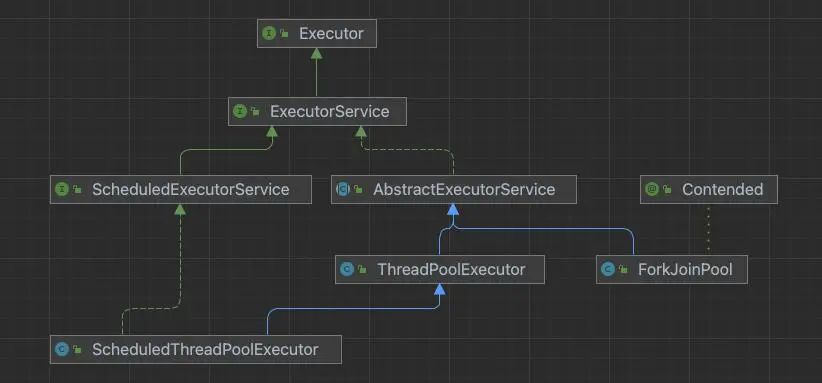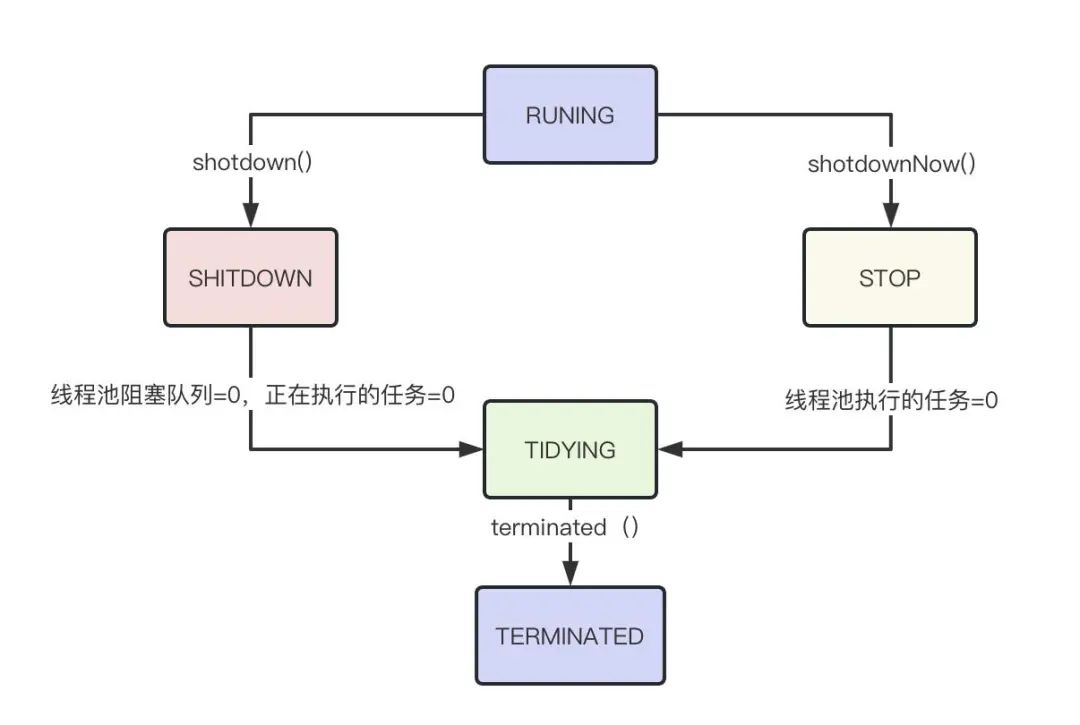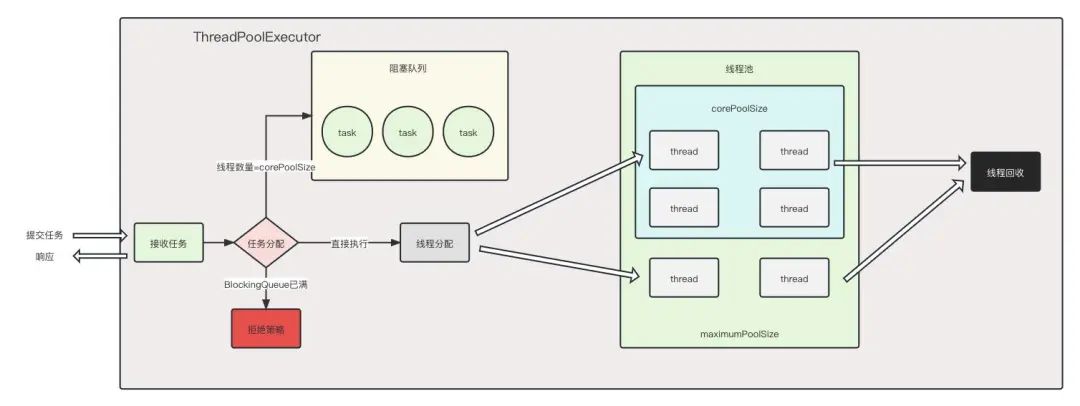线程池 ThreadPoolExecutor 基础介绍
什么是线程?
线程是指进程中的一个执行流程,一个进程中可以运行多个线程。比如 java.exe 进程中可以运行很多线程。线程总是属于某个进程,线程没有自己的虚拟地址空间,与进程内的其他线程一起共享分配给该进程的所有资源。
线程在执行过程中与进程是有区别的。每个独立的线程有一个程序运行的入口、顺序执行序列和程序的出口。但是线程不能够独立执行,必须依存在应用程序中,由应用程序提供多个线程执行控制。
线程是进程的一个实体,是 CPU 调度和分派的基本单位,它是比进程更小的能独立运行的基本单位。线程自己基本上不拥有系统资源,只拥有一点在运行中必不可少的资源(如程序计数器,一组寄存器和栈),但是它可与同属一个进程的其他的线程共享进程所拥有的全部资源。
在 JAVA 中,线程是 java.lang.Thread 类的一个实例。
JAVA 中线程创建的方式?
- 继承 Thread,并重写 run 方法。
- 实现 Runnable,并重写 run 方法。
- 实现 Callable 接口。
什么是线程池?为什么要使用线程池?
线程池,顾名思义,存放线程的池子。线程是比较稀缺的资源,被无限创建的话,会大量消耗系统资源,降低系统的稳定性。JAVA 中的线程池,可以对线程进行统一的管理。
在并发环境下,系统不能够确定在任意时刻中,执行多少任务,投入多少资源。这种不确定性可能会带来一些问题:
- 频繁的创建,删除线程,会带来一定的性能损耗。
- 线程无限创建,可能带来资源耗尽的风险。
- 线程随意的创建,删除。可能会导致系统的不稳定。
线程池解决的核心问题就是资源管理问题。使用线程池的优点:
- 降低资源损耗。通过复用已经创建的线程,来降低线程创建销毁带来的消耗。
- 提高响应速度。当接到任务时,减免了原本需要创建线程所消耗的时间。
- 提高了线程的可管理性。线程由线程池统一管理,调度。合理的使用线程池,能够避免线程的随意创建销毁,增加系统稳定性,控制线程数量,也可以避免资源耗尽的风险。
JAVA 中线程池的继承关系图
Executor 接口是线程框架最基础的部分,该接口只定义一个用于执行 Runnable 的 execute 方法,用来分离任务的提交和任务的执行。
ExecutorService 接口继承了 Executor,在其基础上做了 submit(), shutdown(), invokeAll() 等方法的扩展,算是真正意义上的线程池接口。
AbstractExecutorService 抽象类实现了 ExecutorService 中的部分方法,如部分的 submit(), invokeAll()方法。
ThreadPoolExecutor 是线程池的核心实现类,用来执行被提交的任务。
ScheduledExecutorService 接口继承了 ExecutorService 接口,提供了一些延时执行的方法。
ScheduledThreadPoolExecutor 是一个实现类,可以在给定一个延时后运行命令,或者定时执行命令。

从继承图可以看出,ExecutorService 是线程池的一个比较核心的接口类。该类里面继承了和定义了一些具体的方法:
- void execute(Runnable command); 执行 Runnable 类型的任务。
- Future<?> submit(Runnable/Callable task); 用来提交 Runnable/Callable 任务,并返回该任务的 Future 对象。
- void shutdown(); 在完成已经提交的任务后,关闭。不再接收新的任务。
- List shutdownNow(); 停止所有正在执行的任务,同时不再接收新的任务。
- boolean isTerminated(); 判断是否所有的任务都已经执行完成了。
- boolean isShutdown(); 判断 ExecutorService 是否被关闭。
- List<Future> invokeAll(Collection<? extends Callable> tasks); 执行指定的任务集合,执行完成后返回结果。
- T invokeAny(Collection<? extends Callable> tasks); 执行指定的任务集合,任意一个任务执行完成,返回结果,其他任务终止。
线程池核心实现类之一:ThreadPoolExecutor
public ThreadPoolExecutor(int corePoolSize,
int maximumPoolSize,
long keepAliveTime,
TimeUnit unit,
BlockingQueue<Runnable> workQueue,
ThreadFactory threadFactory,
RejectedExecutionHandler handler) {
if (corePoolSize < 0 || maximumPoolSize <= 0 || maximumPoolSize < corePoolSize || keepAliveTime < 0)
throw new IllegalArgumentException();
if (workQueue == null || threadFactory == null || handler == null) throw new NullPointerException();
this.acc = System.getSecurityManager() == null ? null : AccessController.getContext();
this.corePoolSize = corePoolSize;
this.maximumPoolSize = maximumPoolSize;
this.workQueue = workQueue;
this.keepAliveTime = unit.toNanos(keepAliveTime);
this.threadFactory = threadFactory;
this.handler = handler;
}
线程池创建的各个参数的意义:
corePoolSize:
线程池的核心线程数量,提交一个任务,就会创建一个线程,直到线程数量达到 corePoolSize。
如果线程数量等于 corePoolSize,继续提交任务,则会被保存在线程阻塞队列里,等待执行。
执行线程池的 prestartAllCoreThreads()方法,线程池会提前创建并启用所有的核心线程。
maximumPoolSize:
线程池最大线程数量。
在线程阻塞队列满的时候,继续提交任务,则会创建新的线程执行任务,线程最大的数量不可超过 maximumPoolSize。
keepAliveTime:
线程存货时间。在没有任务需要执行的时候,线程存活的时间。该参数在线程数量大于 corePoolSize 的时候使用。
unit:
keepAliveTime 时间单位。
workQueue:
线程阻塞队列。
当正在执行任务的线程数量等于 corePoolSize 的时候,继续提交任务,任务则会进入 workQueue 等待被执行。
一般情况下,workQueue 都是有限队列,如果 workQueue 是无限队列,可能会对系统带来一定的影响:
- 如果是无限队列,当线程数达到 corePoolSize 时,新任务就会一直进入 workQueue。maximumPoolSize 参数就会无效,同时 keepAliveTime 也会变成无效参数。
- 如果是无限队列,也有可能出现资源耗尽的情况。
常用的 workQueue:ArrayBlockingQueue,LinkedBlockingQueue 等
threadFactory:
线程工厂。
自己设置自定义线程工厂,Executors 的默认线程工厂 DefaultThreadFactory
static class DefaultThreadFactory implements ThreadFactory {
private static final AtomicInteger poolNumber = new AtomicInteger(1);
private final ThreadGroup group;
private final AtomicInteger threadNumber = new AtomicInteger(1);
private final String namePrefix;
DefaultThreadFactory() {
SecurityManager s = System.getSecurityManager();
group = (s != null) ? s.getThreadGroup() : Thread.currentThread().getThreadGroup();
namePrefix = "pool-" + poolNumber.getAndIncrement() + "-thread-";
}
public Thread newThread(Runnable r) {
Thread t = new Thread(group, r, namePrefix + threadNumber.getAndIncrement(), 0);
if (t.isDaemon()) t.setDaemon(false);
if (t.getPriority() != Thread.NORM_PRIORITY) t.setPriority(Thread.NORM_PRIORITY);
return t;
}
}
可以看出默认线程工厂的线程命名规则是:pool-''数字''-thread-"数字"
executionHandler:
拒绝策略。
当线程阻塞队列已满,线程数量也已经到 maximumPoolSize 时,如果继续提交任务,就必须找一种方法处理现在的情况。就有了拒绝策略。线程池提供了四种拒绝策略供大家选择:
AbortPolicy:直接抛出异常,也是线程池的默认拒绝策略。
public static class AbortPolicy implements RejectedExecutionHandler {
/**
* Creates an {@code AbortPolicy}.
*/
public AbortPolicy() { }
/**
* Always throws RejectedExecutionException.
*
* @param r the runnable task requested to be executed
* @param e the executor attempting to execute this task
* @throws RejectedExecutionException always
*/
public void rejectedExecution(Runnable r, ThreadPoolExecutor e) {
throw new RejectedExecutionException("Task " + r.toString() + " rejected from " + e.toString());
}
}
CallerRunsPolicy:用调用者所在的当前线程执行。一般使用在不允许失败,对性要求不高,并发不算太高的场景。如果并发很高,则会造成程序阻塞,性能效率损失很大。
public static class CallerRunsPolicy implements RejectedExecutionHandler {
/**
* Creates a {@code CallerRunsPolicy}.
*/
public CallerRunsPolicy() { }
/**
* Executes task r in the caller's thread, unless the executor
* has been shut down, in which case the task is discarded.
*
* @param r the runnable task requested to be executed
* @param e the executor attempting to execute this task
*/
public void rejectedExecution(Runnable r, ThreadPoolExecutor e) {
if (!e.isShutdown()) {
r.run();
}
}
}
DiscardOldestPolicy:丢弃阻塞队列里面最前面的任务,并开始执行当前任务。
public static class DiscardOldestPolicy implements RejectedExecutionHandler {
/**
* Creates a {@code DiscardOldestPolicy} for the given executor.
*/
public DiscardOldestPolicy() { }
/**
* Obtains and ignores the next task that the executor
* would otherwise execute, if one is immediately available,
* and then retries execution of task r, unless the executor
* is shut down, in which case task r is instead discarded.
*
* @param r the runnable task requested to be executed
* @param e the executor attempting to execute this task
*/
public void rejectedExecution(Runnable r, ThreadPoolExecutor e) {
if (!e.isShutdown()) {
e.getQueue().poll();
e.execute(r);
}
}
}
DiscardPolicy:直接丢弃任务。
public static class DiscardPolicy implements RejectedExecutionHandler {
/**
* Creates a {@code DiscardPolicy}.
*/
public DiscardPolicy() { }
/**
* Does nothing, which has the effect of discarding task r.
*
* @param r the runnable task requested to be executed
* @param e the executor attempting to execute this task
*/
public void rejectedExecution(Runnable r, ThreadPoolExecutor e) {
}
}
线程池的重要属性
private final AtomicInteger ctl = new AtomicInteger(ctlOf(RUNNING, 0));
private static final int COUNT_BITS = Integer.SIZE - 3;
private static final int CAPACITY = (1 << COUNT_BITS) - 1;
ctl:
是对线程池的运行状态,线程池中有效线程数量进行控制的一个字段,ctl 包含两部分信息:线程池的运行状态(runState),线程池内有效线程数量(workerCount);这两个信息用一个 Integer 类型来保存,runState 用高三位保存,workerCount 用低 29 位保存。COUNT_BITS 就是 29,CAPACITY 是 1 左移 29 位再减去 1(二进制就是 29 个 1),这个常量表示 workerCount 的上限值 536870911。
线程池的五种状态
private static final int RUNNING = -1 << COUNT_BITS;
private static final int SHUTDOWN = 0 << COUNT_BITS;
private static final int STOP = 1 << COUNT_BITS;
private static final int TIDYING = 2 << COUNT_BITS;
private static final int TERMINATED = 3 << COUNT_BITS;
- RUNNING :线程池的初始状态,线程池被创建就是 RUNNING 状态,且线程池的任务为 0。线程池处于 RUNNING 状态,能接收新任务,并且能够已添加的任务做处理。
- SHUTDOWN:调用线程池的 shutdown() 接口,线程池的状态会从 RUNNING -> SHUTDOWN。线程池处于 SUTDOWN 状态时,线程池不再接收新任务,可以继续完成已经收到的任务。
- STOP:调用线程池的 shutdownNow() 接口,线程池状态会从 RUNNING/SHUTDOWN -> STOP 。线程池处于 STOP 状态时,线程池不再接收新任务,也不会继续完成已经收到的任务,并中断正在执行的任务。
- TIDYING:当线程池在 SHUTDOWN 状态下,阻塞队列为空并且线程池中执行的任务也为空时,就会由 SHUTDOWN -> TIDYING;当线程池在 STOP 状态下,线程池中执行的任务为空时,就会由 STOP -> TIDYING。当所有的任务已终止,ctl 记录的”任务数量”为 0,线程池会变为 TIDYING 状态。当线程池变为 TIDYING 状态时,会执行钩子函数 terminated()。terminated() 在ThreadPoolExecutor 类中是空的,若用户想在线程池变为 TIDYING 时,进行相应的处理;可以通过重载 terminated() 函数来实现。
- TERMINATED:线程池在 TIDYING 状态下,执行过 terminated() 之后,从 TIDYING -> TERMINATED 状态。线程池彻底终止就变成了 TERMINATED 状态。进入 TERMINATED 状态的条件:(1) 线程池不在 RUNNING;(2) 线程池状态不在 TIDYING/TERMINATED;(3) 线程池的状态是 SHUTDOWN,并且阻塞队列为空时。(4) workerCount=0;(5) 设置 TIDYING 成功。

线程池的工作原理
- 如果当前线程数量少于 corePoolSize 时,新来任务时会获取全局锁创建新的线程;
- 当前线程数量等于或多余 corePoolSize 时,新来任务时则会被加到 BlockingQueue;
- 如果 BlockingQueue 已经满了,则会创建新的线程来处理任务;
- 新创建线程时,如果线程总数即将超过 maximumPoolSize,则当前任务则会被拒绝。

学习总结
本次主要以线程为切入点,并抛砖引玉以提出问题的方式,去学习 JAVA 中 Executor 接口的继承关系,了解到了线程池的核心实现类 ThreadPoolExecutor 的所有参数都是什么含义,学习了四种线程拒绝策略,在不同的业务场景中该如何使用。
通过线程池的一些重要属性学习到了线程池的状态流转机制。进一步了解了线程池的工作原理,真正的知道了线程池的优缺点,以及在什么业务场景下再去使用线程池。
后续会继续学习线程池的相关方法和线程池线程的复用原理。让线程池在业务中能够更合理的使用。
参考文献
- JAVA多线程与线程池技术详解
